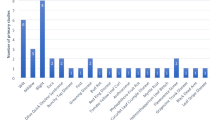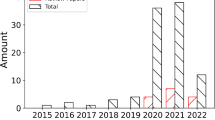Abstract
Purpose of Review
Weed detection systems are important solutions to one of the existing agricultural problems—unmechanized weed control. Weed detection also helps provide a means of reducing or eliminating herbicide use, mitigating agricultural environmental and health impact, and improving sustainability.
Recent Findings
Deep learning-based techniques are replacing traditional machine learning techniques to detect weeds in real time with the development of new models and increasing computational power. More hybrid machine learning models are emerging, utilizing benefits from different techniques. More large-scale crop and weed image datasets are available online now, and this provides more data and opportunities for researchers and engineers to join and contribute to this field.
Summary
This article provides a mini-review of all the different emerging and popular weed detection techniques for selective spraying, and summarizes the trends in this area in the past several years.






Similar content being viewed by others
References
Papers of particular interest, published recently, have been highlighted as: • Of importance •• Of major importance
Noxious Weeds Management In: ARTICLE 1.7. California Legislature. 2018. https: //leginfo.legislature.ca.gov/faces/codes_displayText.xhtml?lawCode=FAC&division=4. &title=&part=4.&chapter=1.&article=1.7. . Accessed 11/2 2019.
Lanini W, Strange M. Low-input management of weeds in vegetable fields. Calif Agric. 1991;45(1):11–3.
Hodgson JM. The nature, ecology, and control of Canada thistle. vol 1386. Agricultural Research service, US Dept. of Agriculture; [for sale by the Supt … ; 1968.
Monaco T, Grayson A, Sanders D. Influence of four weed species on the growth, yield, and quality of direct-seeded tomatoes (Lycopersicon esculentum). Weed Sci. 1981;29(4):394–7.
Nave W, Wax L. Effect of weeds on soybean yield and harvesting efficiency. Weed Sci. 1971;19(5):533–5.
Smith DT, Baker RV, Steele GL. Palmer amaranth (Amaranthus palmeri) impacts on yield, harvesting, and ginning in dryland cotton (Gossypium hirsutum). Weed Technol. 2000;14(1):122–6.
Weis M, Gerhards R. Detection of weeds using image processing and clustering. Bornimer Agrartechnische Berichte. 2008;69(138):e144.
Desai R, Desai K, Desai S, Solanki Z, Patel D, Patel V. Removal of weeds using image processing: a technical review. Int J Adv Comput Technol. 2015;4:27–31.
Weis M. An image analysis and classification system for automatic weed species identification in different crops for precision weed management. 2010.
Choudhary J, Nayak S. A survey on weed detection using image processing in agriculture. Int J Comput Sci Eng. 2016;4(6).
Mustafa MM, Hussain A, Ghazali KH, Riyadi S, editors. Implementation of image processing technique in real time vision system for automatic weeding strategy. 2007 IEEE International Symposium on Signal Processing and Information Technology; 2007: IEEE.
Robovator. VisionWeeding. http://www.visionweeding.com/robovator/. Accessed 11/02 2019.
Herrera P, Dorado J, Ribeiro Á. A novel approach for weed type classification based on shape descriptors and a fuzzy decision-making method. Sensors. 2014;14(8):15304–24.
Aravind R, Daman M, Kariyappa B, editors. Design and development of automatic weed detection and smart herbicide sprayer robot. 2015 IEEE Recent Advances in Intelligent Computational Systems (RAICS); 2015: IEEE.
FarmBot. Genesis Weeder. https://genesis.farm.bot/v1.1/docs/weeder. Accessed 11/01 2019.
VisionWeeding. Robovator. 2019. http://www.visionweeding.com/robovator/. Accessed 11/02 2019.
Weis M, Sökefeld M. Detection and identification of weeds. Precision crop protection-the challenge and use of heterogeneity. Springer; 2010. p. 119–134.
• Sa I, Chen Z, Popović M, Khanna R, Liebisch F, Nieto J, et al. weednet: Dense semantic weed classification using multispectral images and mav for smart farming. IEEE Robot Autom Lett. 2017;3(1):588–95. The results of this study show that NDVI as a distinguishable feature can be used for automatic ground truth generation, and semantic method weed classification provides a different deep learning approach to detect weeds at pixel levels.
Michaels A, Haug S, Albert A, editors. Vision-based high-speed manipulation for robotic ultra-precise weed control. 2015 IEEE/RSJ International Conference on Intelligent Robots and Systems (IROS); 2015: IEEE.
Bakhshipour A, Jafari A, Nassiri SM, Zare D. Weed segmentation using texture features extracted from wavelet sub-images. Biosyst Eng. 2017;157:1–12.
Lavania S, Matey PS, editors. Novel method for weed classification in maize field using Otsu and PCA implementation. 2015 IEEE International Conference on Computational Intelligence & Communication Technology; 2015: IEEE.
Rumpf T, Römer C, Weis M, Sökefeld M, Gerhards R, Plümer L. Sequential support vector machine classification for small-grain weed species discrimination with special regard to Cirsium arvense and Galium aparine. Comput Electron Agric. 2012;80:89–96.
Dyrmann M, Skovsen S, Laursen MS, Jørgensen RN, editors. Using a fully convolutional neural network for detecting locations of weeds in images from cereal fields. International Conference on Precision Agriculture; 2018: International Society of Precision Agriculture.
Sarker MI, Kim H. Farm land weed detection with region-based deep convolutional neural networks. arXiv preprint arXiv:190601885. 2019.
Yu J, Sharpe SM, Schumann AW, Boyd NS. Detection of broadleaf weeds growing in turfgrass with convolutional neural networks. Pest Manag Sci. 2019.
dos Santos FA, Freitas DM, da Silva GG, Pistori H, Folhes MT. Weed detection in soybean crops using ConvNets. Comput Electron Agric. 2017;143:314–24.
Wendel A, Underwood J, editors. Self-supervised weed detection in vegetable crops using ground based hyperspectral imaging. 2016 IEEE International Conference on Robotics and Automation (ICRA); 2016: IEEE.
Garcia-Ruiz FJ, Wulfsohn D, Rasmussen J. Sugar beet (Beta vulgaris L.) and thistle (Cirsium arvensis L.) discrimination based on field spectral data. Biosyst Eng. 2015;139:1–15.
Dyrmann M, Jørgensen RN, Midtiby HS. RoboWeedSupport-Detection of weed locations in leaf occluded cereal crops using a fully convolutional neural network. Adv Anim Biosci. 2017;8(2):842–7.
Myers D, Ross CM, Liu B, editors. A review of unmanned aircraft system (UAS) applications for agriculture. 2015 ASABE Annual International Meeting; 2015: American Society of Agricultural and Biological Engineers.
Liu B. Wireless sensor network applications in precision agriculture. J Agric Syst Technol Manag. 2018;29:25–37.
• Lottes P, Khanna R, Pfeifer J, Siegwart R, Stachniss C, editors. UAV-based crop and weed classification for smart farming. 2017 IEEE International Conference on Robotics and Automation (ICRA); 2017: IEEE. The findings from this paper show that UAV-based images can be successfully used to map and identify weeds.
Torres-Sánchez J, López-Granados F, Peña JM. An automatic object-based method for optimal thresholding in UAV images: application for vegetation detection in herbaceous crops. Comput Electron Agric. 2015;114:43–52.
David LCG, Ballado AH, editors. Vegetation indices and textures in object-based weed detection from UAV imagery. 2016 6th IEEE International Conference on Control System, Computing and Engineering (ICCSCE); 2016: IEEE.
Peña J, Torres-Sánchez J, Serrano-Pérez A, de Castro A, López-Granados F. Quantifying efficacy and limits of unmanned aerial vehicle (UAV) technology for weed seedling detection as affected by sensor resolution. Sensors. 2015;15(3):5609–26.
Barrero O, Rojas D, Gonzalez C, Perdomo S, editors. Weed detection in rice fields using aerial images and neural networks. 2016 XXI Symposium on Signal Processing, Images and Artificial Vision (STSIVA); 2016: IEEE.
López-Granados F, Torres-Sánchez J, Serrano-Pérez A, de Castro AI, Mesas-Carrascosa F-J, Pena J-M. Early season weed mapping in sunflower using UAV technology: variability of herbicide treatment maps against weed thresholds. Precis Agric. 2016;17(2):183–99.
Thenkabail PS, Lyon JG. Hyperspectral remote sensing of vegetation. CRC press; 2016.
Peerbhay KY, Mutanga O, Ismail R. Random forests unsupervised classification: the detection and mapping of Solanum mauritianum infestations in plantation forestry using hyperspectral data. IEEE J Sel Top Appl Earth Observ Remote Sens. 2015;8(6):3107–22.
Gao J, Nuyttens D, Lootens P, He Y, Pieters JG. Recognising weeds in a maize crop using a random forest machine-learning algorithm and near-infrared snapshot mosaic hyperspectral imagery. Biosyst Eng. 2018;170:39–50.
Karimi Y, Prasher S, Patel R, Kim S. Application of support vector machine technology for weed and nitrogen stress detection in corn. Comput Electron Agric. 2006;51(1–2):99–109.
Pantazi X-E, Moshou D, Bravo C. Active learning system for weed species recognition based on hyperspectral sensing. Biosyst Eng. 2016;146:193–202.
Longchamps L, Panneton B, Samson G, Leroux GD, Thériault R. Discrimination of corn, grasses and dicot weeds by their UV-induced fluorescence spectral signature. Precis Agric. 2010;11(2):181–97.
Wang P, Peteinatos G, Li H, Gerhards R. Rapid in-season detection of herbicide resistant Alopecurus myosuroides using a mobile fluorescence imaging sensor. Crop Prot. 2016;89:170–7.
Panneton B, Guillaume S, Roger J-M, Samson G. Improved discrimination between monocotyledonous and dicotyledonous plants for weed control based on the blue-green region of ultraviolet-induced fluorescence spectra. Appl Spectrosc. 2010;64(1):30–6.
Suzuki Y, Okamoto H, Kataoka T. Image segmentation between crop and weed using hyperspectral imaging for weed detection in soybean field. Environ Control Biol. 2008;46(3):163–73.
USDA. National Statistics for Lettuce. 2018. https://www.nass.usda.gov/Statistics_by_Subject/result.php?CA67122E-5AF3-3058-B89C-6D375960D1F8§or=CROPS&group=VEGETABLES&comm=LETTUCE. Accessed 11/2 2019.
•• Redmon J, Farhadi A, editors. YOLO9000: better, faster, stronger. Proceedings of the IEEE conference on computer vision and pattern recognition; 2017. The proposed model enables real-time, high accuracy and multiple-oboject localization in many applications.
Otsu N. A threshold selection method from gray-level histograms. IEEE Trans Syst Man Cybern. 1979;9(1):62–6.
He K, Zhang X, Ren S, Sun J, editors. Deep residual learning for image recognition. Proceedings of the IEEE conference on computer vision and pattern recognition; 2016.
Sandler M, Howard A, Zhu M, Zhmoginov A, Chen L-C, editors. Mobilenetv2: Inverted residuals and linear bottlenecks. Proceedings of the IEEE Conference on Computer Vision and Pattern Recognition; 2018.
Szegedy C, Ioffe S, Vanhoucke V, Alemi AA, editors. Inception-v4, inception-resnet and the impact of residual connections on learning. Thirty-First AAAI Conference on Artificial Intelligence; 2017.
Iandola FN, Han S, Moskewicz MW, Ashraf K, Dally WJ, Keutzer K. SqueezeNet: AlexNet-level accuracy with 50x fewer parameters and< 0.5 MB model size. arXiv preprint arXiv:160207360. 2016.
Simonyan K, Zisserman A. Very deep convolutional networks for large-scale image recognition. arXiv preprint arXiv:14091556. 2014.
Author information
Authors and Affiliations
Corresponding author
Ethics declarations
Conflict of Interest
The authors declare that they have no conflict of interest.
Human and Animal Rights and Informed Consent
This article does not contain any studies with human or animal subjects performed by any of the authors.
Additional information
Publisher’s Note
Springer Nature remains neutral with regard to jurisdictional claims in published maps and institutional affiliations.
This article is part of the Topical Collection on Agriculture Robotics
Rights and permissions
About this article
Cite this article
Liu, B., Bruch, R. Weed Detection for Selective Spraying: a Review. Curr Robot Rep 1, 19–26 (2020). https://doi.org/10.1007/s43154-020-00001-w
Published:
Issue Date:
DOI: https://doi.org/10.1007/s43154-020-00001-w




